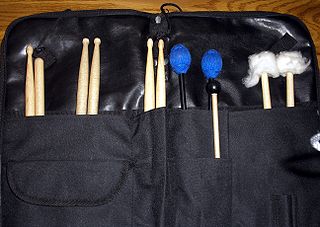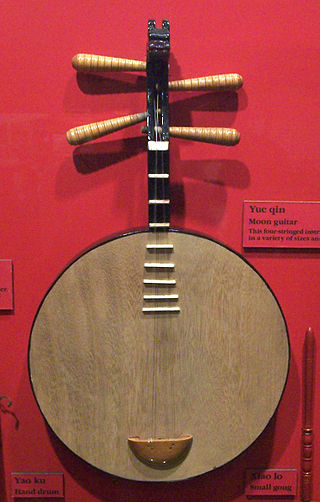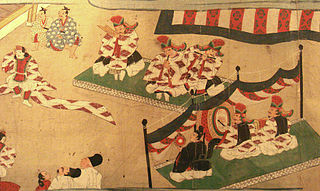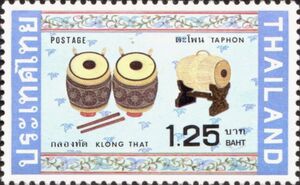
A drum kit is a collection of drums, cymbals, and sometimes other auxiliary percussion instruments set up to be played by one person. The drummer typically holds a pair of matching drumsticks or special wire or nylon brushes; and uses their feet to operate hi-hat and bass drum pedals.

Indonesia is a country with many different tribes and ethnic groups, and its music is also very diverse, coming in hundreds of different forms and styles. Every region has its own culture and art, and as a result traditional music from area to area also uniquely differs from one another. For example, each traditional type of music is often accompanied by its very own dance and theatre. Contemporary music scene have also been heavily shaped by various foreign influences, such as America, Britain, Japan, Korea, and India.

Korea has produced music for thousands of years, into the modern day. After the division of Korea in 1945, both North and South Korea have produced their own styles of music.

A wooden fish, also known as a Chinese temple block, wooden bell, or muyu, is a type of woodblock that originated from East Asia that is used by monks and lay people in the Mahayana tradition of Buddhism. They are used in Buddhist ceremonies in China, Korea, Japan, Vietnam and other Asian countries. They may be referred to as a Chinese block, Korean block or, rarely, as a skull.
Gagaku is a type of Japanese classical music that was historically used for imperial court music and dances. Gagaku was developed as court music of the Kyoto Imperial Palace, and its near-current form was established in the Heian period (794–1185) around the 10th century. Today, it is performed by the Board of Ceremonies in the Tokyo Imperial Palace.

A percussion mallet or beater is an object used to strike or beat a percussion instrument to produce its sound.

The yueqin, also called a moon lute or moon guitar, is a traditional Chinese string instrument. It is a lute with a round, hollow soundboard, a short fretted neck, and usually four strings. It is an important instrument in the Peking opera orchestra, often taking the role of main melodic instrument in lieu of the bowed string section.

The fangxiang is an organized-suspended (bianxuan) Chinese metallophone that has been used for over 1,000 years. It was first used in the Liang dynasty (502—557 CE), and then standardized in the Sui and Tang dynasties mostly for court music.

The paixiao is a Chinese wind instrument, a form of pan flute. A major difference between the Chinese Paixiao and the panpipes used in European and South American traditions, is that at the top of the Chinese instrument the pipe holes are each cut angled or with notches. This allows for bending the pitch in similar capacity to the dongxiao down a minor second. This allows Chinese paixiao to be fully chromatic without loss in timbre, even though the included pipes are tuned diatonically. The method of blowing so is to hold the head of the frame with both hands, with the mouthpiece facing the front, place the lower lip on the mouthpiece, and find and blow each tube according to the pitch.

The janggu or seyogo is a drum often used in traditional Korean music. It consists of an hourglass-shaped body with two heads made from various types of leather. The two heads produce sounds of different pitch and timbre, which when played together are believed to represent the harmonious joining of Um and Yang. The janggu is one of the four components of samul nori (사물놀이), alongside the buk (북), jing (징) and kkwaenggwari (꽹과리).

The buk (Korean: 북) is a traditional Korean drum. While the term buk is a native Korean word used as a generic term meaning "drum", it is most often used to refer to a shallow barrel-shaped drum, with a round wooden body that is covered on both ends with animal skin. Buk are categorized as hyeokbu which are instruments made with leather, and has been used for jeongak and folk music.
The kakko is a Japanese double-headed drum. Kakko drums are usually laid sideways on stands, and are played on both drumheads with sticks known as bachi. Kakko drums have been used in taiko ensembles, but are also used in the gagaku form of older Japanese court music.

Traditional Korean musical instruments comprise a wide range of string, wind, and percussion instruments. Many traditional Korean musical instruments derive from Chinese musical instruments.

Hourglass drums are a sub-category of membranophone, or drum, characterized by an hourglass shape. They are also known as waisted drums. Drumheads are attached by laces, which may be squeezed during a performance to alter the pitch. The category also includes pellet drums such as the damaru, although not all pellet drums are hourglass shaped.

Traditional Japanese music is the folk or traditional music of Japan. Japan's Ministry of Education classifies hōgaku as a category separate from other traditional forms of music, such as gagaku or shōmyō, but most ethnomusicologists view hōgaku, in a broad sense, as the form from which the others were derived. Outside of ethnomusicology, however, hōgaku usually refers to Japanese music from around the 17th to the mid-19th century. Within this framework, there are three types of traditional music in Japan: theatrical, court music, and instrumental.

The bipa is a pear-shaped lute that is a traditional Korean musical instrument. It is derived from Chinese pipa and was introduced through the Silk Road to Goguryeo and Silla. There are two major types of bipa: the four stringed dang-bipa and the five stringed hyang-bipa. While dang-bipa was a Tang-style pipa first introduced from the Chinese Tang dynasty and localized over time to have Korean characteristics, hyang-bipa was created in the Korean Kingdom of Silla. The instrument is also related to other derivatives such as Vietnamese đàn tỳ bà and the Japanese biwa.
The galgo is a traditional Korean drum. The drum has an hourglass-shaped wooden body and two drum heads of identical diameter, similar to the janggu. Compared to the janggu, the galgo is fitted with a sound-adjusting funnel that is different. The galgo uses thinner drum skins and is struck with two bamboo sticks, chae; the mallet shaped gungchae is not used. The pitch of the drum can be controlled on both sides of the drum rather than only one pitch per-side for the janggu.

(Thai: กลองทัด, pronounced[klɔːŋtʰát]) are large barrel drums used in the classical music of Thailand. They are played with large wooden sticks. They are usually played in a pair and used in the piphat ensemble. Drums of this kind have also been called klong chatri (กลองชาตรี) and klong túk (กลองตุ๊ก).

The fou is an ancient Chinese percussion instrument consisting of a pottery or bronzeware crock, jar, pot, or similar vessel, which was struck with a stick. Its origin dates back to the Xia or Shang dynasties, where it was used in ritual music. It later became a standard instrument in Confucian ritual ensembles.

Korean drums play an important part in traditional Korean music, ranging from folk music to royal court music. There are a wide variety of shapes and sizes, for use both in accompanying other instruments and in special drumming performances.















